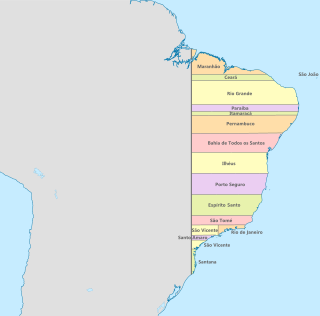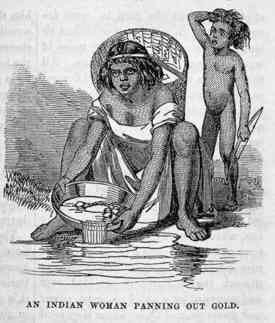
During the Age of Discovery, a large scale colonization of the Americas, involving a number of European countries, took place primarily between the late 15th century and the early 19th century. The Norse had explored and colonized areas of Europe and the North Atlantic, colonizing Greenland and creating a short term settlement near the northern tip of Newfoundland circa 1000 CE. However, the later colonization by the European powers involving the continents of North America and South America is arguably more well-known.

Human history in California began when indigenous Americans first arrived some 13,000 years ago. Coastal exploration by the Spanish began in the 16th century, with further European settlement along the coast and in the inland valleys following in the 18th century. California was part of New Spain until that kingdom dissolved in 1821, becoming part of Mexico until the Mexican–American War (1846–1848), when it was ceded to the United States under the terms of the 1848 Treaty of Guadalupe Hidalgo. The same year, the California Gold Rush began, triggering intensified U.S. westward expansion. California joined the Union as a free state via the Compromise of 1850. By the end of the 19th century, California was still largely rural and agricultural, with a population of about 1.4 million.

Slavery in the colonial history of the United States refers to the institution of slavery as it existed in the European colonies which eventually became part of the United States. In these colonies, slavery developed due to a combination of factors, primarily the labour demands for establishing and maintaining European colonies, which had resulted in the Atlantic slave trade. Slavery existed in every European colony in the Americas during the early modern period, and both Africans and indigenous peoples were victims of enslavement by European colonizers during the era.

Colonial Brazil comprises the period from 1500, with the arrival of the Portuguese, until 1815, when Brazil was elevated to a kingdom in union with Portugal as the United Kingdom of Portugal, Brazil and the Algarves. During the early 300 years of Brazilian colonial history, the economic exploitation of the territory was based first on brazilwood extraction, which gave the territory its name; sugar production ; and finally on gold and diamond mining. Slaves, especially those brought from Africa, provided most of the work force of the Brazilian export economy after a brief period of Indian slavery to cut brazilwood.

Slavery in the Spanish American colonies was an economic and social institution which existed throughout the Spanish Empire including Spain itself. In its American territories, early Spanish monarchs put forth laws against enslaving Indigenous peoples of the Americas. Queen Isabella outlawed the enslavement of Native Americans in the Spanish colonies of the New World because she viewed the natives as subjects of the Spanish monarchy. While Spain displayed an early abolitionist stance towards the Indigenous, some instances of illegal Native American slavery continued to be practiced by rogue individuals, particularly until the New Laws of 1543 which expressly prohibited it.

The history of California can be divided into the Native American period, the European exploration period (1542–1769), the Spanish colonial period (1769–1821), the Mexican period (1821–1848), and United States statehood. California was one of the most culturally and linguistically diverse areas in pre-Columbian North America. After contact with Spanish explorers, many of the Native Americans died from foreign diseases. Finally, in the 19th century there was a genocide by United States government and private citizens, which is known as the California genocide.

Peter Hardeman Burnett was an American politician who served as the first elected Governor of California from December 20, 1849, to January 9, 1851. Burnett was elected Governor almost one year before California's admission to the Union as the 31st state in September 1850.

The Spanish and Mexican governments made many concessions and land grants in Alta California and Baja California from 1775 to 1846. The Spanish Concessions of land were made to retired soldiers as an inducement for them to settle in the frontier. These Concessions reverted to the Spanish crown upon the death of the recipient.

Slavery in Brazil began long before the first Portuguese settlement was established in 1516, with members of one tribe enslaving captured members of another. Later, colonists were heavily dependent on indigenous labor during the initial phases of settlement to maintain the subsistence economy, and natives were often captured by expeditions of bandeirantes. The importation of African slaves began midway through the 16th century, but the enslavement of indigenous peoples continued well into the 17th and 18th centuries.

Slavery among Native Americans in the United States includes slavery by and slavery of Native Americans roughly within what is currently the United States of America.

Slavery among the Indigenous peoples of the Americas refers to slavery of and by the Indigenous peoples of the Americas. The history of slavery spans all regions of the world; during the pre-Columbian era, many societies in the Americas enslaved prisoners of war or instituted systems of forced labor. Contact with Europeans transformed these practices, as the Spanish introduced chattel slavery through warfare and the cooption of existing systems. A number of other European powers followed suit, and from the 15th through the 19th centuries, between two and five million Indigenous people were enslaved, which had a devastating impact on many Indigenous societies, contributing to the overwhelming population decline of Indigenous peoples in the Americas.

Afro Salvadorans are the descendants of the Sub-Saharan Africans brought to El Salvador via the Trans-atlantic slave trade during the colonial Spanish era.
Archy Lee (1840–1873), was an African American man born into enslavement; and was later part of a series of notable 19th-century court cases that defined civil rights in the state of California. In 1857, he was brought from Mississippi to Sacramento, California and continued to work as if he was enslaved. He escaped while in California, but was later arrested and brought to a few court trials. By April 14, 1858, he was legally declared a free man by the state of California.

Slavery in Latin America was an economic and social institution that existed in Latin America before the colonial era until its legal abolition in the newly independent states during the 19th century. However, it continued illegally in some regions into the 20th century. Slavery in Latin America began in the pre-colonial period when indigenous civilizations, including the Maya and Aztec, enslaved captives taken in war. After the conquest of Latin America by the Spanish and Portuguese, of the nearly 12 million slaves that were shipped across the Atlantic, over 4 million enslaved Africans were brought to Latin America. Roughly 3.5 million of those slaves were brought to Brazil.

Forced labor in California existed as a system technically different but similar to chattel slavery. While California's state constitution outlawed slavery, the 1850 Act for the Government and Protection of Indians allowed the indenture of Native Californians. The act allowed for a system of custodianship for indigenous children and a system of convict leasing. These systems were backed by the legalized corporal punishment of any Native Californian, and the stripping of many legal rights of Native Californians.

Slavery was practiced in Colombia from the beginning of the 16th century until its definitive abolition in 1851. This process consisted of trafficking in people of African and indigenous origin, first by the European colonizers from Spain and later by the commercial elites of the Republic of New Granada, the country that contained what is present-day Colombia.
The largest slave traders in Mexican territory were the Portuguese and the English. The countries that controlled the transatlantic slave market in terms of number of slaves shipped were Great Britain, France, and Portugal.

An Act for the Admission of the State of California into the Union is the federal legislation that admitted California to the United States as the thirty-first state. California is one of only a few states to become a state without first being an organized territory.

The history of slavery in Colorado began centuries before Colorado achieved statehood when Spanish colonists of Santa Fe de Nuevo México (1598–1848) enslaved Native Americans, called Genízaros. Southern Colorado was part of the Spanish territory until 1848. Comanche and Utes raided villages of other indigenous people and enslaved them.
The Other Slavery: The Uncovered Story of Indian Enslavement in America is a book about Native American slavery written by Andrés Reséndez and published by Houghton Mifflin Harcourt in 2016.
















